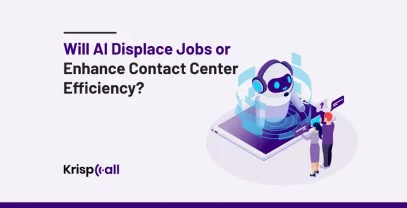Imagine the frustration of dealing with customer issues while constantly battling with the call center background noise.😖
According to the research, the high noise level within contact centers could reduce productivity by up to 66%. To a contact center agent, noise is not a mere nuisance that can be ignored but a real contender that poses a threat to their performance and increases their stress level.🤯
The clock is ticking⏰, so without delay, let’s dive deep into the impact of noise in contact centers, especially on agents’ performance, different types of noises, and how it may be mitigated to enhance performance and deliver excellent services.
🗝️ KEY HIGHLIGHTS:
- Call centers can reduce noise by soundproofing windows or doors, increasing space between agents, and using noise-canceling headphones.
- Various background noises from the call centers impact agent performance, the company’s productivity, and customer experience.
- The noises in the contact centers can be ambient, external, interpersonal, external, and transient.
- In the future, Virtual Reality (VR) and Augmented Reality (AR) solutions may be utilized to enhance learning and virtual teamwork in contact centers.
Understanding Noise In Contact Centers
Understanding noise exposure in contact centers helps the employees maintain stress levels, decreasing agent burnout and fatigue. The more we understand the main core of the incoming noise, the more we can take action to reduce that noise. 🔕
Similarly, we can measure the noise level in contact centers using sound level meters, dosimeters, noise mapping, employee surveys, and feedback. Noise mapping software draws or plots noise distribution and shows noisy areas, with studies showing typical call center noise levels ranging from 60-70 dB.
Qualitative data is collected through employee surveys and feedback so that actual issues related to noise can be determined and periods in the day when disturbances are most likely to occur. According to the result, noise can reduce productivity by up to 66%.
Furthermore, sound level meters read decibel levels instantly, while dosimeters measure an individual’s noise exposure to verify compliance. For example, the Occupational Safety and Health Administration (OSHA) recommends that workplace noise should not exceed 85 dB over an 8-hour period.
Types Of Noises In Contact Centers
The types of noises in contact centers are:
1. Ambient Noise
Ambient noise is noise that is continuously present in an environment or continues while something is happening. Similarly, these kinds of noises arise from office HVAC systems, air conditioning, people talking from a distance, and general noise from the office environment.
Although ambient noise can be gradual and low in intensity, it can create a hum that increases overall stress over time. When noise levels are not effectively managed, they prevent one from focusing on the work and hearing certain conversations that should be understood clearly.
2. Operational Noise
Operational noise is the noise created by the call center equipment and the activities carried out in the facility on a daily basis. Furthermore, this type of noise arises from the sounds of ringing phones, keys being typed, faxing, printing, photocopying, and other noise-making machinery used in the office.
The impact of operational noise at work regulations is making workers unable to work efficiently. Since, workers have a hard time hearing themselves and also hearing their colleagues as they attend to clients on the phone. This causes higher stress levels and lowers productivity.
3. Interpersonal Noise
Interpersonal noise is created by the interpersonal communication observed or occurred among the employees in the call center. Interpersonal noise sources are work-related conversations, casual conversations, or group and team discussions and meetings.
It is essential to have some degree of interpersonal communication; however, loud voices interrupt other employees’ work. If this type of noise issue continues in the work environment, it will cause an uncoordinated working environment.
4. External Noise
External noise is an intrusive noise source that originates from outside the contact center but has intervened in the environment. It arises mainly from car honks, builders’ banging, passing cars, trucks, buses, rain drops, wind, and many others.
This call center background noise must be reduced as it impacts the communication process between users and agents. Likewise, external noise can interfere with phone conversations and even cause distractions that demote employees’ concentration levels.
5. Transient Noise
Transient noise is the type of noise in the contact center that appears as brief signals that may be so interrupting in nature. These noises come from forces such as a telephone ringing, opening a door, speaking extremely loud, a bell ringing, or someone yelling.
However, transient noise should be managed and reduced if you want a contact center to maintain an efficient workflow environment. These noises lead agents to ask customers to repeat themselves or clarify information more often. This may create call center burnout.
Impacts Of Noise On Contact Center’s Performance & Productivity
Noise in call centers can impact an agent’s performance and productivity or customer burnout, whether agents work from home or the office. Here are some of the impacts of noise on the contact center’s performance and productivity:
A. Impact On Agent Productivity
Noise, such as ringing phones, printers, and other people’s conversations, interferes with agents’ concentration during calls. Similarly, stress and agent fatigue are other problems that arise from loud sounds.
On the other hand, customers may be requested to restate what they said more often because of noises that interfere with the conversation and interrupt an agent’s work. According to many reports, the industry cost of misunderstandings or requiring repetition is more than a billion per year.
B. Impact On Customer Experience
Noise in the contact center also has a big impact on customer experience. Background noises make it hard for customers to understand the messages agents convey, making them agitated and dissatisfied. If the customers are not satisfied, then the customer retention rate will decrease.
Also, if customers have disruptions many times during the call, the contact center will be seen by them as unprofessional. This type of loss is quantified and calculated to be 84%, as claimed by the agents, and can be managed through a thorough assessment of the noise sources in the call center environment.
C. Impact On The Quality Of Calls And Analysis
Noisy call recordings are likely to obscure the information that quality assurance teams take their time to evaluate. Loud noises can distort audio and distract agents from work, which directly impacts the quality of calls.
Temporary sounds should not interfere with statistics such as Average Handle Time (AHT) or First Call Resolution (FCR) if the agents require additional time to explain something. According to analysis, background noise has a direct influence on 89% of agents’ KPIs.
How To Reduce Background Noise In A Contact Center?
Call center background noise must be reduced as quickly as possible to improve customer satisfaction, smoothen agents’ performance, and obtain clear communication. Installing acoustic panels and using noise-canceling headsets can make your contact center quieter.
However, here are some effective noise-reduction techniques in a call center:
1. Increase Space Between Call Center Agents
To enhance customer satisfaction and churn rate, your call center should increase the space between agents. Optimizing this process means reducing the direct transmission of sound, leading to a quieter workforce environment.
Similarly, increasing the space between agents reduces the likelihood of distractions, allowing a more productive work atmosphere. Also, enhanced spacing in the call center allows for better implementation of noise-reducing strategies like acoustic panels.
2. Using Noise-Canceling Headsets
The use of noise-canceling headsets assists in minimizing the level of noise that enters a call. These headsets incorporate modern technology by reducing background noises, blocking sounds, and helping agents and customers listen and be understood.
Likewise, this enhances the quality of calls to be handled and minimizes the circumstances under which the customers and the agents have to repeat themselves. Also, agents can use noise-canceling headphones to minimize the stress that arises from various noises and disturbances.
3. Optimizing The Use Of Soundproof Windows And Doors
Soundproof your call center by optimizing insulated windows and doors in the call center, which can protect it against street noise from transport, construction work, or neighbors. These soundproofing measures involve special materials and a thorough assessment of the noise sources that help minimize outside noises.
Thus, by reducing these external noises, the total noise within the contact center is reduced and offers an ideal working environment. Furthermore, better sound isolation leads to increased organizational efficiency and better comfort for the workers, reducing agent burnout.
4. Training Programs For Agents
To help employees learn about noise or background noise, training involves enlightening employees about how noise hinders their work and the surroundings. Similarly, some fundamental measures like using low-intensity communication instruments and avoiding idle talking can develop the culture of keeping the noise level low.
On the other hand, by using awareness and encouraging these practices, the employees become conscious of how noisy they are and how much it affects others. Thus, striving together results in noise reduction, time-saving, and employee satisfaction in office spaces.
5. Collecting Agents’ Feedback
Feedback from the agents working in the contact center about the noise level and their personal experience while working should be collected. This practice reduces noise in some instances and helps to identify where the noise is actually coming from and where it disrupts productivity.
However, feedback from employees also helps the call centers understand employees’ concerns, and agents can suggest solutions for reducing external noise. Soundproofing techniques like silent keyboards and shifting noisy employees to separate rooms can be suggested in the feedback by the agents.
Benefits Of Having A Quieter Contact Center
There are several benefits of having a quieter contact center. If the call centers are not noisy, then the efficiency increases, increasing business peak productivity. Here are some benefits of a quiet contact center:
- Enhanced communication clarity: Reduced noise enhances the quality of transmissions, improving communication not only between agents and customers but also with management. This minimizes misunderstandings and enhances problem-solving.
- Increased employee productivity: Less noise ensures that the agents pay attention to the work they are handling, hence increasing the speed of handling calls. Similarly, lower noise levels can increase call center employees’ work productivity.
- Improved employee well-being: No noise in work regulations ensures less stress, and the employees can have a healthy break from burnout. It provides the employees with great satisfaction and reduces their frustration, hence retaining them.
- Better customer experience: Clarity and decreased interruption time contribute positively to customers’ final payoff. Likewise, happy customers will revisit the services and may refer others to the service provider, hence improving the company’s reputation.
- More accurate call analysis: A quieter contact center ensures that the call center operator and the customers are not disturbed and that recorded calls are clear for further quality control and training. This results in the correct measurement of performance and training achievements.
Future Trends Of Noise Management In Contact Center
As cloud contact centers become more complex, several emerging issues will define how noise management will develop in the future, benefiting both agents and customers. The contact center will optimize the noise management techniques to smoothen the working atmosphere.
Similarly, contact centers may utilize innovations in the future to prevent noise, including soundproofing products, silent keyboards, and fabric covered with noise-deadening factors. The call center may also opt for environmental sensors that constantly measure the existing noise levels and adjust elements such as sound masking.
In addition to these materials, AI-integrated noise-cancelling headsets will be issued as agents’ equipment. These headsets incorporate sophisticated signal processing to reduce the number of unwanted sounds and provide clear audio during a conversation. Implementing physical solutions such as fire rated acoustic foam, acoustic ceiling, and other soundproofing measures will further contribute to the effective remote work environment.
Moreover, Virtual Reality (VR) and Augmented Reality(AR) solutions may be utilized to enhance learning and virtual teamwork. These technologies will ensure that agents who work remotely are provided with a quiet environment in which they can carry out their tasks effectively without noise hampering their work.
Thus, in the future, call centers will focus on developing a proper worker environment that is proven to positively impact employee’s psychological state through proper design and sounds. Also, the focus on the specific guidelines and standards regarding noise management in the industry will be done.
Conclusion
In conclusion, one can admit that noise in call centers not only causes mere annoyance but also negatively affects organizational efficiency as well as employees’ and customers’ satisfaction through elevated noise levels. Installing acoustic panels and optimizing handling time effectively address these issues.
It is unbelievable, but the effect of noise on call centers is far-reaching. The future of effective noise management initiatives would not only hold the key to a more productive employee-customer experience but also considerably improve agents’ interactions by addressing both noise exposure and sound quality. Now is the time to act—let’s quiet down and crank up the success!





